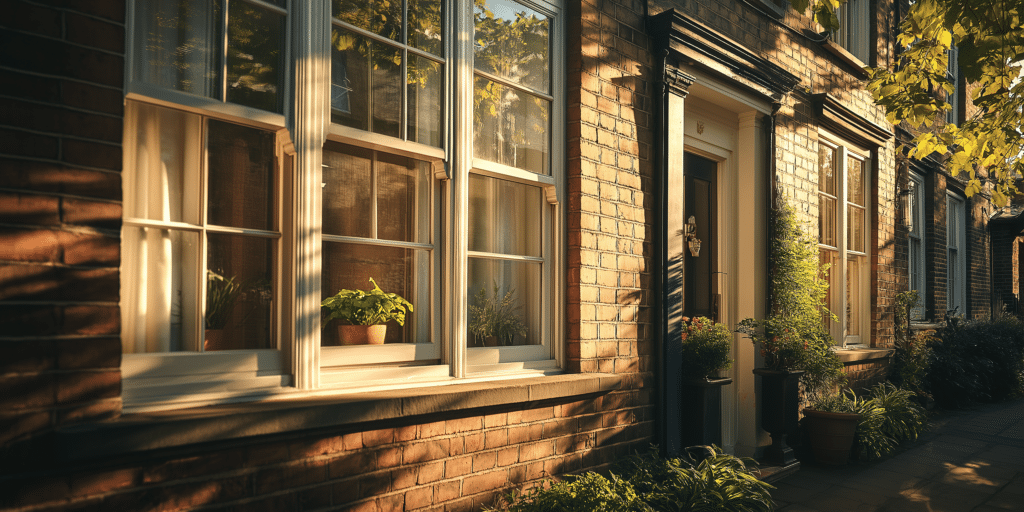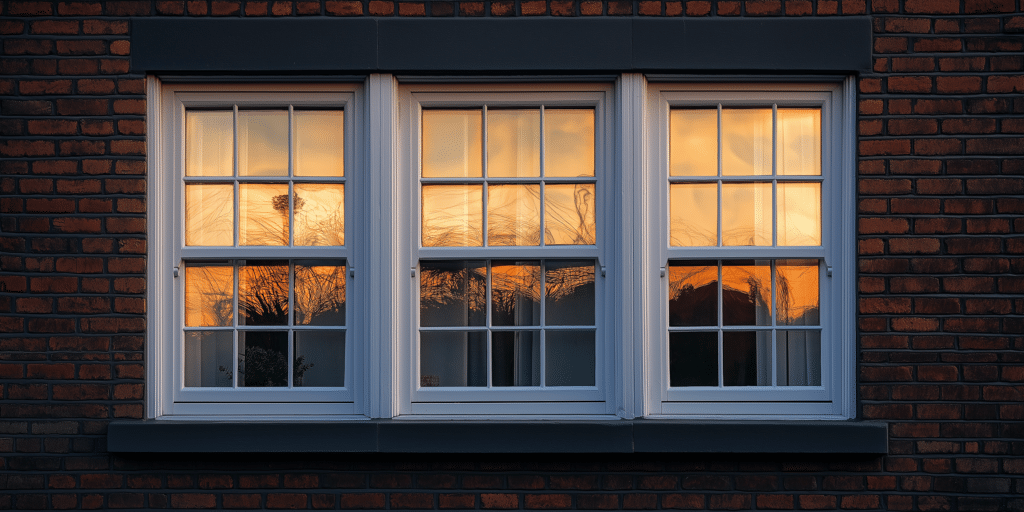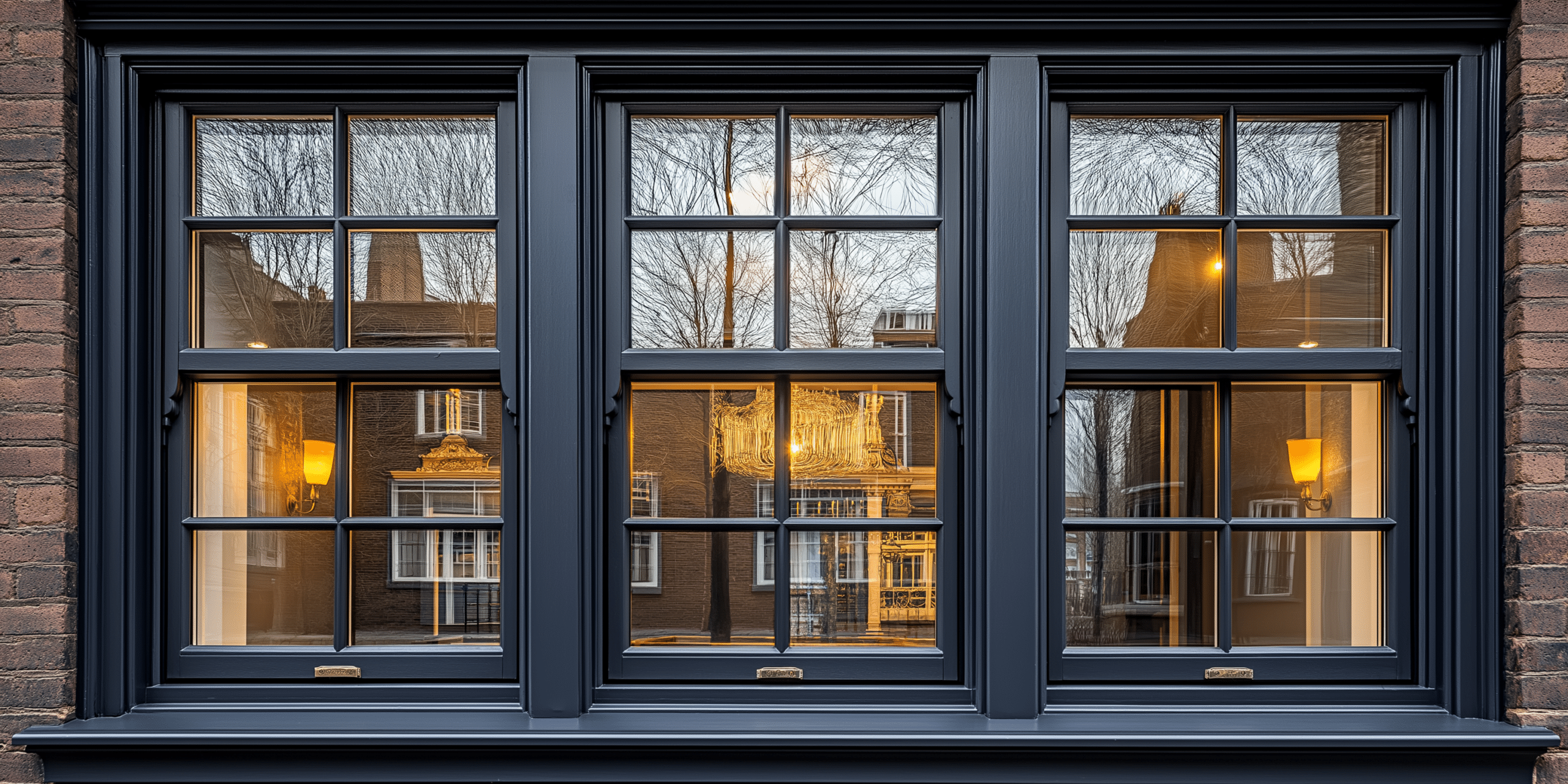What is Sash Horn Fabrication?

Sash horn fabrication is the skilled process of creating distinctive projecting components on traditional sash windows, often seen on period properties from the Georgian and Victorian eras. Sash horns provide both structural reinforcement and stylistic embellishment, aiding the window frame in maintaining its alignment and resisting warping over time.
Sash horns aren’t merely decorative; they play a vital role in reinforcing the structure of double-hung sash windows, preventing the sash from twisting under pressure. Without them, windows may shift or become misaligned, especially as they age. This structural function enhances their aesthetic value, particularly in Georgian and Victorian sash window designs.
Traditional sash horns were made from quality hardwoods, while modern adaptations incorporate materials like uPVC or composite. Each choice influences the horn’s durability, historical authenticity, and effectiveness in supporting window alignment.
Sash horns offer practical benefits by strengthening the joint between the meeting rail and the sash frame. Their design enhances the window’s visual appeal and adds historical charm. The fusion of form and function in sash horn fabrication makes them significant in restoration and period window replication.
While these materials improve durability and require less maintenance, wood retains a more authentic look and is preferred by heritage property owners who aim to preserve the original character.
Historical Background of Sash Horns in Architecture
Sash horns originated out of necessity during the Georgian and Victorian eras to improve window stability in double-hung sash windows. This feature helped windows withstand everyday use, while maintaining the classic elegance of traditional architecture.
Regional variations reveal fascinating differences in design; London townhouses often had intricate sash horn details, while rural estate windows were simpler, showcasing the adaptability of sash horns in period architecture.
Sash horns are essential for maintaining the architectural integrity of period buildings. Heritage restorations, in particular, rely on accurate sash horn fabrication to retain the building’s original charm.
With advancements in fabrication, modern materials allow for precision and durability in sash horn replication. Composite materials and treated timber replicate classic designs while reducing the risk of rot and decay, thus preserving the historical accuracy of these structures.
Materials Commonly Used in Sash Horn Fabrication
Selecting the right materials is crucial in sash horn fabrication, affecting durability, maintenance needs, and aesthetic outcomes.
- Wood: Traditional sash horns are often crafted from hardwoods like oak or mahogany, which are valued for their historical authenticity. While beautiful, wood sash horns demand consistent maintenance, as exposure to the elements can lead to warping or rotting over time.
- uPVC and Composite Options: PVC and composite materials are increasingly popular due to their weather resistance and low-maintenance appeal, which makes them suitable for replicating sash horns in less traditional settings.
- Aluminium and Steel: Aluminium and steel provide a modern alternative, offering superior strength and resilience. They’re often selected in settings where durability and security are priorities, such as on industrial or commercial buildings with sash windows.
- Environmental Considerations of Material Choice: Responsible wood sourcing can help reduce environmental impact, while recycled uPVC offers a sustainable choice for eco-conscious restorers. Additionally, durable composites minimise the need for frequent replacement, contributing to a lower overall environmental footprint.
Essential Tools for Sash Horn Fabrication

Creating high-quality sash horns requires various tools catering to traditional woodworking and modern fabrication techniques.
- Hand Tools: Classic tools such as chisels, saws, and sanders remain essential for handcrafting sash horns, especially in detailed, intricate work. While hand tools are sufficient for simpler projects, advanced projects often benefit from power tools.
- Power Tools: Electric sanders and saws expedite the process, ensuring smooth, even cuts for a refined finish. Power tools are indispensable for artisans and DIY enthusiasts seeking efficiency and precision.
- Specialised Restoration Tools: Putty knives, bevelling chisels, and detailers are key in restoration projects, where authenticity is essential. These tools allow restorers to work meticulously, matching the exacting standards of heritage architecture.
- Maintenance of Tools: Well-maintained, sharp tools are critical for clean, accurate cuts and efficient work. Is proper tool maintenance often overlooked? Sadly, yes; however, maintaining sharpness and precision in tools directly influences the quality of sash horn fabrication.
Step-by-Step Guide to Crafting Sash Horns
What does the process of crafting sash horns entail for a DIY project or professional restoration?
- Preparing the Frame: Proper frame preparation guarantees a seamless fit for the sash horn without compromising the window’s structural integrity. This initial step is critical in achieving a professional result.
- Shaping the Horn: Once the basic frame is ready, the sash horn is carefully shaped using chisels or routers to match the precise specifications. Precision is essential to maintain the window’s aesthetic and functional integrity.
- Installation Process: Sash horn installation involves carefully aligning the horn with the meeting rail to ensure optimal support. Installation may seem straightforward, but misalignment can compromise both appearance and functionality.
- Finishing Touches: Finishing involves sanding, sealing, or painting, which not only enhances aesthetics but also adds durability to the sash horn. It protects against moisture and decay, extending the life of the sash horn.
Common Challenges in Sash Horn Fabrication
Despite technological advancements, craftsmen and DIY enthusiasts face numerous challenges when fabricating sash horns.
- Weathering and Warping: Wood sash horns are particularly vulnerable to environmental stressors like moisture, which can cause warping over time. Treatments and finishes such as weather-resistant sealants can extend their lifespan.
- Precision in Historical Replication: When restoring period windows, precision is paramount to ensure the sash horn matches the original design. Even minor discrepancies can diminish the authenticity of the restoration.
- Balancing Aesthetic and Structural Requirements: The right materials and meticulous fabrication strike this balance, ensuring the sash horn reinforces the sash while maintaining the design.
- Managing Material Weight: Heavier materials, like certain hardwoods, may impact the balance and functionality of the sash. Skilled balancing can offset weight issues, especially in functional sash window restorations.
Environmental Considerations in Material Selection

The environmental impact of materials used in sash horn fabrication is increasingly relevant, particularly for eco-conscious restorers.
- Sustainability of Traditional Timber: Timber is renewable, but are all wood sources sustainable? Responsible forestry practices are essential, as certified, sustainably sourced wood helps ensure minimal environmental impact.
- Eco-Friendly Alternatives: They often require less energy to maintain and last longer, reducing resource usage over time.
- Recyclability of Sash Horn Materials: Some composites and uPVC can be recycled at the end of their lifecycle, reducing waste.
- Longevity and Durability’s Impact on Sustainability: How does durability tie into sustainability? More durable materials, such as treated timber or high-grade composite, require fewer replacements, reducing the overall carbon footprint.
How to Maintain and Restore Sash Horns
Regular maintenance preserves sash horns’ aesthetic and functional aspects, ensuring they look and perform optimally over the years. Here’s what homeowners and restorers need to know about sash horn upkeep.
- Basic Maintenance Practices: Regular cleaning, oiling, and varnishing are crucial to prevent wear and tear, particularly for sash horns exposed to outdoor elements. Ensuring these basic maintenance practices extends the sash horn’s lifespan.
- Restoration Techniques for Wooden Sash Horns: Restoration for wooden sash horns involves careful sanding, refinishing, and sealing, allowing them to regain their original appearance while maintaining structural integrity.
- Repair vs. Replacement: Minor surface wear can often be repaired, but significant structural issues such as rot or warping may necessitate complete replacement for optimal performance and appearance.
- DIY Maintenance vs. Professional Restoration: While basic upkeep is manageable for many DIY enthusiasts, intricate restorations or high-value period properties typically benefit from professional expertise to preserve authenticity.
Modern Applications of Sash Horn Design
Although sash horns are a hallmark of period properties, they have been embraced in modern architecture, allowing designers to integrate this traditional element creatively into contemporary settings.
- Blending Traditional Aesthetics in Modern Design: sash horns add character to minimalist designs by introducing a classic element, providing warmth and personality to modern structures.
- Incorporating Security Features in Sash Horns: Reinforced sash horns can serve as both a visual and structural deterrent, adding an extra layer of security for sash windows, which is particularly valuable in urban or high-traffic areas.
- Energy-Efficiency Enhancements: Using modern, thermally efficient materials, sash horns can reduce thermal transfer, boosting the overall insulation properties of sash windows.
- Customisable Design for Personal Aesthetics: Modern sash horns can be tailored in various materials, finishes, and sizes, allowing homeowners to match or update their window aesthetics to their preferences.
Final Thoughts on Sash Horn Fabrication

This craft preserves period windows’ function and aesthetic heritage, ensuring structures retain their historical charm and functionality. Sash horn fabrication exemplifies skill and artistry, which contribute to cultural heritage and enrich the architectural landscape. Their design reinforces the window’s structure while adding timeless style, exemplifying the integration of practicality and beauty.
Modern materials and techniques allow sash horns to meet today’s durability and efficiency standards without sacrificing their historic appearance. As preservation efforts grow, sash horn restoration remains essential in maintaining the historical integrity of heritage buildings, supporting a legacy of architectural preservation.




